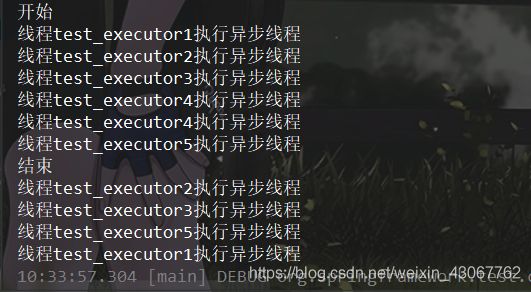SSM配置和使用ThreadPoolTaskExecutor线程池
为什么使用线程池?
提升性能:它们通常在执行大量异步任务时,由于减少了每个任务的调用开销,并且它们提供了一种限制和管理资源(包括线程)的方法,使得性能提升明显
在配置使用ThreadPoolTaskExecutor前,先了解ThreadPoolExecutor,以及它们两个的区别
一、ThreadPoolExecutor

1、 ThreadPoolExecutor是jdk线程池中的一个类,它继承了AbstractExecutorService类,而AbstractExecutorService类实现了Executorservice接口,Executorservice继承了Executor接口
2、Executor接口
Executor接口是线程池最顶层的一个接口,它只有一个方法void execute(Runnable command): 在未来某个时间执行给定的命令。该命令可能在新的线程、已入池的线程或者正调用的线程中执行,这由 Executor 实现决定。
3、ExecutorService接口
ExecutorService是一个接口,提供了管理终止的方法,以及可为跟踪一个或多个异步任务执行状况而生成Future 的方法。
它有三个实现类:AbstractExecutorService(默认实现类) , ScheduledThreadPoolExecutor和 ThreadPoolExecutor。
Executors 提供了此接口的几种常用实现的工厂方法,用来创建合适的线程池,返回ExecutorService类型的线程池。方法如下:
ExecutorService newFixedThreadPool() : 创建固定大小的线程池
ExecutorService newCachedThreadPool() : 缓存线程池,线程池的数量不固定,可以根据需求自 动的更改数量。
ExecutorService newSingleThreadExecutor() : 创建单个线程池。 线程池中只有一个线程
ScheduledExecutorService newScheduledThreadPool() : 创建固定大小的线程,可以延迟或定时的执行。
public class Executors {
/**
* Creates a thread pool that reuses a fixed number of threads
* operating off a shared unbounded queue. At any point, at most
* {@code nThreads} threads will be active processing tasks.
* If additional tasks are submitted when all threads are active,
* they will wait in the queue until a thread is available.
* If any thread terminates due to a failure during execution
* prior to shutdown, a new one will take its place if needed to
* execute subsequent tasks. The threads in the pool will exist
* until it is explicitly {@link ExecutorService#shutdown shutdown}.
*
* @param nThreads the number of threads in the pool
* @return the newly created thread pool
* @throws IllegalArgumentException if {@code nThreads <= 0}
*/
public static ExecutorService newFixedThreadPool(int nThreads) {
return new ThreadPoolExecutor(nThreads, nThreads,
0L, TimeUnit.MILLISECONDS,
new LinkedBlockingQueue<Runnable>());
}
/**
* Creates a thread pool that maintains enough threads to support
* the given parallelism level, and may use multiple queues to
* reduce contention. The parallelism level corresponds to the
* maximum number of threads actively engaged in, or available to
* engage in, task processing. The actual number of threads may
* grow and shrink dynamically. A work-stealing pool makes no
* guarantees about the order in which submitted tasks are
* executed.
*
* @param parallelism the targeted parallelism level
* @return the newly created thread pool
* @throws IllegalArgumentException if {@code parallelism <= 0}
* @since 1.8
*/
public static ExecutorService newWorkStealingPool(int parallelism) {
return new ForkJoinPool
(parallelism,
ForkJoinPool.defaultForkJoinWorkerThreadFactory,
null, true);
}
一、ThreadPoolTaskExecutor
类名org.springframework.scheduling.concurrent.ThreadPoolTaskExecutor
从类名可以看出这是spring提供的线程池
从它的初始化方法中可以看出,它的底层是ThreadPoolExecutor
@Override
protected ExecutorService initializeExecutor(
ThreadFactory threadFactory, RejectedExecutionHandler rejectedExecutionHandler) {
BlockingQueue<Runnable> queue = createQueue(this.queueCapacity);
ThreadPoolExecutor executor = new ThreadPoolExecutor(
this.corePoolSize, this.maxPoolSize, this.keepAliveSeconds, TimeUnit.SECONDS,
queue, threadFactory, rejectedExecutionHandler);
if (this.allowCoreThreadTimeOut) {
executor.allowCoreThreadTimeOut(true);
}
this.threadPoolExecutor = executor;
return executor;
}
1.ThreadPoolTaskExecutor的简介
ThreadPoolTaskExecutor是InitializingBean、DisposableBean的实现类,
spring容器后会自动处理其初始化方法和注销方法,我们只需配置bean即可。
线程池的单例问题,交给spring容器实现单例,不用自己实现单例
2.使用基于xml的方式创建配置
<!-- spring线程池 -->
<bean id="taskExecutor" class="org.springframework.scheduling.concurrent.ThreadPoolTaskExecutor">
<!-- 核心线程数 -->
<property name="corePoolSize" value="5"/>
<!-- 最大线程数 -->
<property name="maxPoolSize" value="10"/>
<!-- 队列最大长度 >=mainExecutor.maxSize -->
<property name="queueCapacity" value="999999"/>
<!-- 线程池维护线程所允许的空闲时间 -->
<property name="keepAliveSeconds" value="20"/>
<!-- 线程名字前缀 -->
<property name="threadNamePrefix" value="test_executor"/>
<!-- 线程池对拒绝任务(无线程可用)的处理策略 -->
<property name="rejectedExecutionHandler">
<bean class="java.util.concurrent.ThreadPoolExecutor$CallerRunsPolicy"/>
</property>
</bean>
ThreadPoolTaskExecutor的拒绝策略:
rejectedExectutionHandler参数字段用于配置绝策略,常用拒绝策略如下
AbortPolicy:用于被拒绝任务的处理程序,它将抛出RejectedExecutionException
CallerRunsPolicy:用于被拒绝任务的处理程序,它直接在execute方法的调用线程中运行被拒绝的任务。
DiscardOldestPolicy:用于被拒绝任务的处理程序,它放弃最旧的未处理请求,然后重试execute。
DiscardPolicy:用于被拒绝任务的处理程序,默认情况下它将丢弃被拒绝的任务。
提交任务:
无返回值的任务使用execute(Runnable)
有返回值的任务使用submit(Runnable)
无返回值测试:
@Service("demo")
public class Demo {
@Autowired
private ThreadPoolTaskExecutor taskExecutor;
public void async(){
taskExecutor.execute(new Runnable() {
@Override
public void run() {
System.out.println("线程" + Thread.currentThread().getName() + "执行异步线程" );
}
});
}
}
@RunWith(SpringJUnit4ClassRunner.class)
@ContextConfiguration({
"classpath:spring-context.xml"})
@ActiveProfiles("development")
public class TestTest {
@Autowired
private Demo demo;
@Test
public void test(){
System.out.println("开始");
for (int i = 1; i <= 10; i++) {
demo.async();
}
System.out.println("结束");
}
}
结果:
执行流程:
1.当一个任务被提交到线程池时,首先查看线程池的核心线程是否都在执行任务,否就选择一条线程执行任务,是就执行第二步。
2.查看核心线程池是否已满,不满就创建一条线程执行任务,否则执行第三步。
3.查看任务队列是否已满,不满就将任务存储在任务队列中,否则执行第四步。
4.查看线程池是否已满,不满就创建一条线程执行任务,否则就按照策略处理无法执行的任务。
在ThreadPoolExecutor中表现为:
1.如果当前运行的线程数小于corePoolSize,那么就创建线程来执行任务(执行时需要获取全局锁)。
2.如果运行的线程大于或等于corePoolSize,那么就把task加入BlockQueue。
3.如果创建的线程数量大于BlockQueue的最大容量,那么创建新线程来执行该任务。
4.如果创建线程导致当前运行的线程数超过maximumPoolSize,就根据饱和策略来拒绝该任务。
springboot中@Async多线程注解使用
